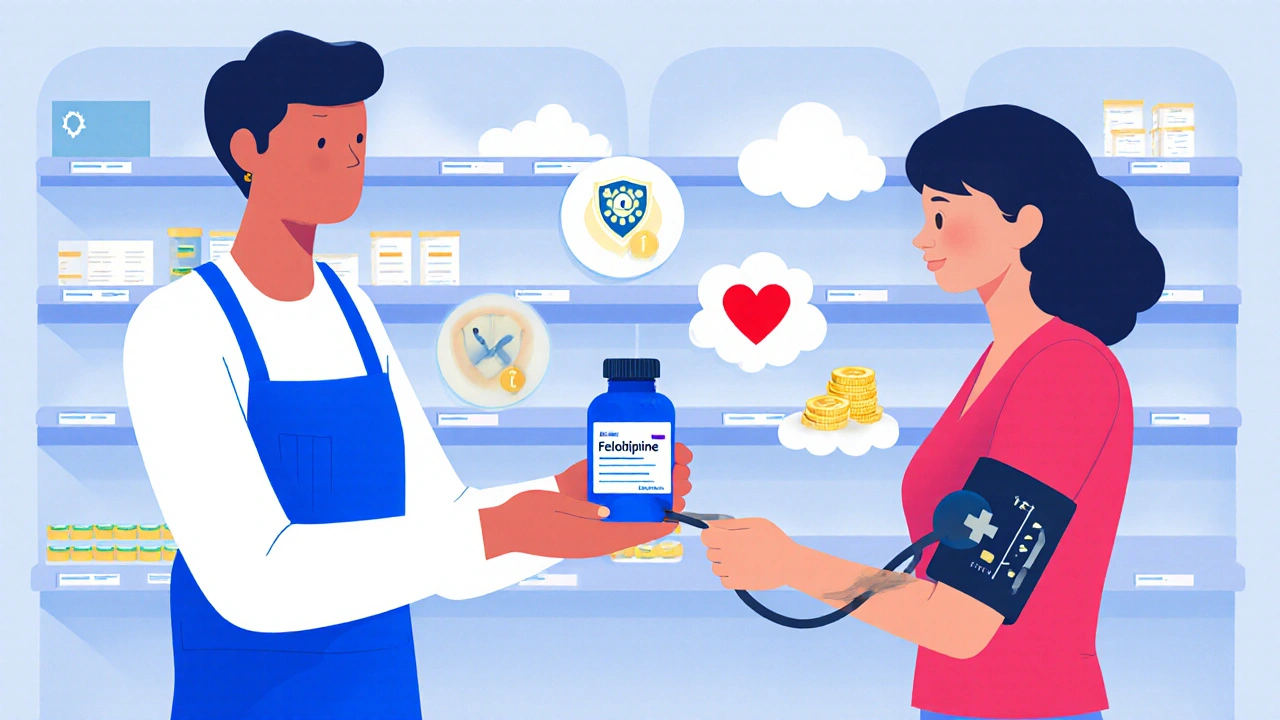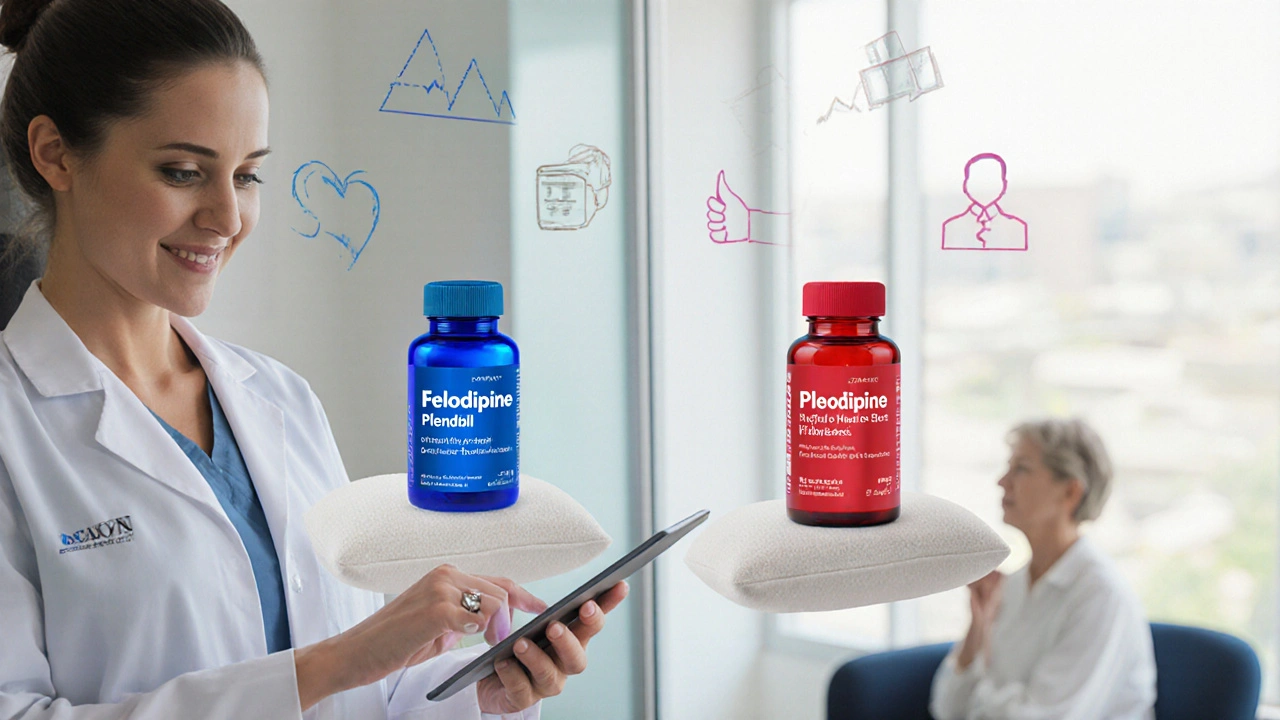Antihypertensive Medication Selector
This tool helps determine which blood pressure medication might be most suitable based on your medical history and preferences.
Medical Conditions
Preferences
Recommended Medication:
When your doctor prescribes Felodipine under the brand name Plendil, you probably wonder whether it’s the best fit for your hypertension or if another pill might work better. This guide breaks down how Felodipine stacks up against the most common alternatives, covering how each drug works, typical doses, efficacy, side‑effects, and who might benefit most.
Quick Takeaways
- Felodipine is a third‑generation dihydropyridine calcium‑channel blocker (CCB) that relaxes arterial smooth muscle.
- Compared with older CCBs like nifedipine, Felodipine offers smoother blood‑pressure control with fewer sudden drops.
- Amlodipine and lercanidipine provide similar efficacy but differ in dosing frequency and edema risk.
- ACE inhibitors (e.g., lisinopril) and ARBs (e.g., losartan) work via the renin‑angiotensin system and are often first‑line for patients with diabetes or kidney disease.
- Beta‑blockers and thiazide diuretics remain useful partners in combination therapy, especially when heart‑rate control or fluid‑balance is needed.
What Is Felodipine and How Does It Work?
Felodipine is a third‑generation dihydropyridine calcium‑channel blocker that selectively inhibits L‑type calcium channels in vascular smooth muscle. By preventing calcium influx, it reduces vasoconstriction, leading to lower systemic vascular resistance and, ultimately, a drop in systolic and diastolic blood pressure.
The drug’s long half‑life (about 20hours) permits once‑daily dosing, and its gradual onset minimizes the “first‑dose” hypotension sometimes seen with older CCBs.
Standard Dosing and Administration
- Initial dose for most adults: 5mg once daily, preferably in the morning.
- Typical maintenance range: 5‑10mg daily; some patients may go up to 20mg if tolerated.
- Take with or without food; avoid grapefruit juice as it can raise plasma levels.
- Renal or hepatic impairment: no dose adjustment needed for mild‑to‑moderate disease, but monitor closely in severe cases.
Efficacy Snapshot
Clinical trials show Felodipine reduces systolic blood pressure by an average of 10-15mmHg and diastolic pressure by 5-10mmHg after 4‑6weeks of therapy. Its effect is comparable to other dihydropyridine CCBs but with a lower incidence of rapid‑onset hypotension.
Side‑Effect Profile
Common adverse events (≥5% of users) include peripheral edema, headache, flushing, and dizziness. Because Felodipine preferentially dilates arteries rather than veins, fluid retention tends to be milder than with nifedipine. Rarely, patients report tachycardia or gingival overgrowth.
Important safety notes:
- Do not combine with strong CYP3A4 inhibitors (e.g., ketoconazole) without dose reduction.
- Pregnancy category C - avoid unless benefits outweigh risks.
- Monitor electrolytes if used alongside diuretics.

How Felodipine Compares With Other Calcium‑Channel Blockers
Below is a side‑by‑side look at three popular CCBs that often compete with Felodipine in clinical practice.
| Attribute | Felodipine (Plendil) | Amlodipine (Norvasc) | Nifedipine (Adalat) | Lercanidipine (Zanidip) |
|---|---|---|---|---|
| Generation | 3rd‑gen dihydropyridine | 3rd‑gen dihydropyridine | 1st‑gen dihydropyridine | 3rd‑gen dihydropyridine |
| Half‑life | ~20h | 30‑50h | 2‑5h (extended‑release forms longer) | ≈15h |
| Once‑daily dosing? | Yes | Yes | Typically once‑daily (ER) or twice‑daily (IR) | Yes |
| Typical dose range | 5‑20mg | 5‑10mg | 10‑60mg (ER) | 10‑20mg |
| Edema incidence | Moderate | Low‑moderate | High | Low |
| First‑dose hypotension | Rare | Rare | Common (especially IR) | Rare |
| Cost (UK, 2025) | £0.12 per tablet (generic) | £0.15 per tablet (generic) | £0.10 per tablet (generic ER) | £0.18 per tablet (generic) |
Key observations:
- Felodipine and amlodipine share a smooth blood‑pressure curve, while nifedipine (especially immediate‑release) can cause abrupt drops.
- Lercanidipine appears to cause the least peripheral edema but is slightly pricier.
- All four agents are once‑daily, making adherence easier.
How Felodipine Stacks Up With Other Antihypertensive Classes
Sometimes doctors swap a CCB for a drug that works through a completely different pathway. Here’s how Felodipine compares with the most frequently prescribed alternatives.
- Lisinopril - an ACE inhibitor that blocks conversion of angiotensin I to II. Best for patients with diabetic nephropathy or heart‑failure. Usually lowers systolic pressure by 8‑12mmHg. Cough is the most common side‑effect.
- Losartan - an ARB that blocks angiotensin‑II receptors. Similar efficacy to ACE inhibitors but with lower cough risk. Often paired with a diuretic for resistant hypertension.
- Metoprolol - a beta‑blocker reducing heart‑rate and cardiac output. Useful after myocardial infarction or in arrhythmias. May cause fatigue or cold extremities.
- Hydrochlorothiazide - a thiazide diuretic that reduces plasma volume. Often the cheapest monotherapy; can raise uric acid and glucose levels.
When choosing between these classes, consider co‑existing conditions. For example, a patient with chronic kidney disease typically receives an ACE‑inhibitor or ARB first, whereas a smoker with isolated systolic hypertension may do well on a CCB like Felodipine.
Who Might Prefer Felodipine Over the Others?
- Older adults who need a steady, once‑daily pill without sudden drops in blood pressure.
- Patients intolerant to edema caused by nifedipine but who still want a vasodilator.
- Those with moderate liver disease where a drug with less hepatic metabolism (compared to amlodipine) is advantageous.
- Individuals on poly‑therapy where a low‑dose CCB can fill the gap without overlapping side‑effects.
Choosing the Right Antihypertensive: A Quick Checklist
- Identify co‑morbidities (diabetes, heart failure, CKD).
- Assess risk of edema, cough, or electrolyte disturbances.
- Consider dosing convenience - once‑daily preferred for adherence.
- Review drug‑interaction potential (e.g., CYP3A4 inhibitors).
- Factor in cost and insurance coverage in the UK (NHS formularies).
If the checklist points to a need for smooth vascular relaxation without cough, Felodipine is a solid pick. If kidney protection is paramount, ACE inhibitors or ARBs take precedence.
Potential Pitfalls and How to Avoid Them
- Sudden dose changes - always titrate gradually; jumping from 5mg to 20mg can spike edema.
- Grapefruit juice - blocks CYP3A4, raising Felodipine levels; advise patients to avoid.
- Concurrent diuretics - monitor potassium and creatinine, especially if the patient has renal impairment.
- Pregnancy - switch to a safer alternative like labetalol if blood‑pressure control is needed.
Bottom Line
Felodipine holds its own against other CCBs and offers a respectable alternative to drugs that target the renin‑angiotensin system, beta‑adrenergic receptors, or renal tubules. The decision boils down to the patient’s overall health profile, side‑effect tolerance, and cost considerations.

Frequently Asked Questions
Can I switch from nifedipine to Felodipine?
Yes. Because both are dihydropyridine CCBs, you can cross‑taper. Start Felodipine at 5mg once daily while halving the nifedipine dose, then discontinue nifedipine after 3‑5days. Monitor blood pressure and edema closely.
Is Felodipine safe for people with asthma?
Felodipine has minimal effect on bronchial smooth muscle, so it’s generally safe for asthmatics. Beta‑blockers would be a higher‑risk choice.
How long does it take to see a blood‑pressure drop?
Most patients notice a measurable reduction within 2‑4weeks of a stable dose. Full effect may continue to improve up to 6‑8weeks.
What should I do if I develop ankle swelling?
First, confirm the swelling isn’t due to heart failure or kidney disease. If it’s mild, elevating the legs and reducing salt intake can help. For moderate edema, your doctor may lower the dose or add a low‑dose thiazide diuretic.
Can Felodipine be taken with a statin?
Yes. No clinically relevant interaction has been documented between Felodipine and commonly used statins such as atorvastatin or simvastatin.

